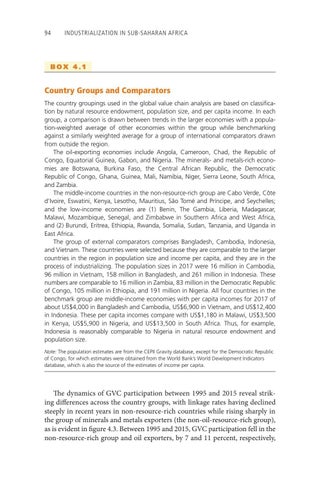94 Industrialization in Sub-Saharan Africa
BOX 4.1
Country Groups and Comparators The country groupings used in the global value chain analysis are based on classification by natural resource endowment, population size, and per capita income. In each group, a comparison is drawn between trends in the larger economies with a population-weighted average of other economies within the group while benchmarking against a similarly weighted average for a group of international comparators drawn from outside the region. The oil-exporting economies include Angola, Cameroon, Chad, the Republic of Congo, Equatorial Guinea, Gabon, and Nigeria. The minerals- and metals-rich economies are Botswana, Burkina Faso, the Central African Republic, the Democratic Republic of Congo, Ghana, Guinea, Mali, Namibia, Niger, Sierra Leone, South Africa, and Zambia. The middle-income countries in the non-resource-rich group are Cabo Verde, Côte d’Ivoire, Eswatini, Kenya, Lesotho, Mauritius, São Tomé and Príncipe, and Seychelles; and the low-income economies are (1) Benin, The Gambia, Liberia, Madagascar, Malawi, Mozambique, Senegal, and Zimbabwe in Southern Africa and West Africa, and (2) Burundi, Eritrea, Ethiopia, Rwanda, Somalia, Sudan, Tanzania, and Uganda in East Africa. The group of external comparators comprises Bangladesh, Cambodia, Indonesia, and Vietnam. These countries were selected because they are comparable to the larger countries in the region in population size and income per capita, and they are in the process of industrializing. The population sizes in 2017 were 16 million in Cambodia, 96 million in Vietnam, 158 million in Bangladesh, and 261 million in Indonesia. These numbers are comparable to 16 million in Zambia, 83 million in the Democratic Republic of Congo, 105 million in Ethiopia, and 191 million in Nigeria. All four countries in the benchmark group are middle-income economies with per capita incomes for 2017 of about US$4,000 in Bangladesh and Cambodia, US$6,900 in Vietnam, and US$12,400 in Indonesia. These per capita incomes compare with US$1,180 in Malawi, US$3,500 in Kenya, US$5,900 in Nigeria, and US$13,500 in South Africa. Thus, for example, Indonesia is reasonably comparable to Nigeria in natural resource endowment and population size. Note: The population estimates are from the CEPII Gravity database, except for the Democratic Republic of Congo, for which estimates were obtained from the World Bank’s World Development Indicators database, which is also the source of the estimates of income per capita.
The dynamics of GVC participation between 1995 and 2015 reveal striking differences across the country groups, with linkage rates having declined steeply in recent years in non-resource-rich countries while rising sharply in the group of minerals and metals exporters (the non-oil-resource-rich group), as is evident in figure 4.3. Between 1995 and 2015, GVC participation fell in the non-resource-rich group and oil exporters, by 7 and 11 percent, respectively,

